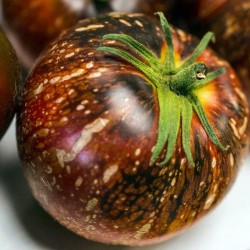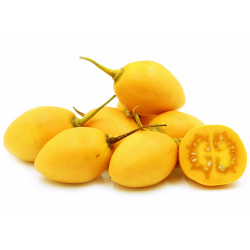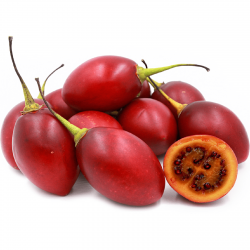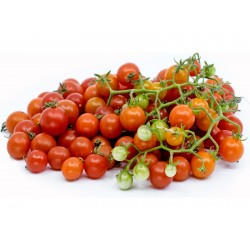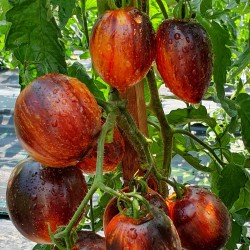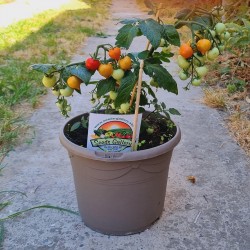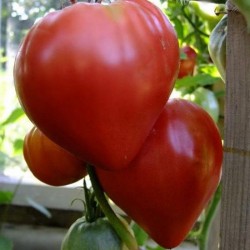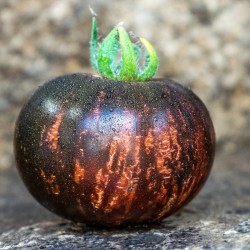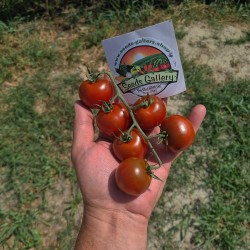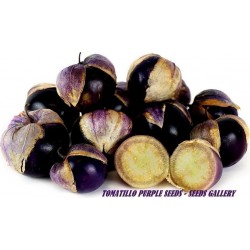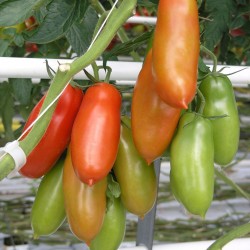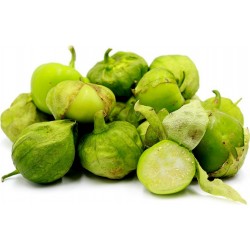Seeds Gallery EU,
5/
5
<h2><span style="color: #000000;"><strong>Tamarillo Seeds (Cyphomandra Betacea)</strong></span></h2>
<h2><span style="color: #ff0000;"><strong>Price for Package of 5<strong> or 10 s</strong>eeds.</strong></span></h2>
<p>Cyphomandra betacea, also known as the tree tomato, or tamarillo, is a small evergreen and fast-growing tree, that originates from several regions of South America, including Peru and Chile. This small tree has large heart-shaped leaves, fragrant flowers that are borne into clusters, red edible fruits.</p>
<p>The tomato tree is frost-hardy to 26°F to 28°F (-2°C to -3°C), and will best be grown in summer.</p>
<p>Newly planted tamarillos should be pruned to a height of 3 to 4 ft. to encourage branching. Yearly pruning thereafter is advisable to eliminate branches that have already fruited and to induce ample new shoots close to the main branches, since fruit is produced on new growth. Pruning also aids in harvesting, and if timed properly can extend the total fruiting period.</p>
<p>Hardiness Zone US 8-11 Aus 2-5 </p>
<div>
<h2><strong>WIKIPEDIA:</strong></h2>
<div><span>The </span><b>tamarillo</b><span> is a small tree or </span>shrub<span> in the </span>flowering plant<span> family </span>Solanaceae<span> (the nightshade family). It is best known as the species that bears the </span><b>tamarillo</b><span>, an egg-shaped edible </span>fruit<span>.</span><sup id="cite_ref-tamarillocom_2-0" class="reference">[2]</sup><span> It is also known as the </span><b>tree tomato</b><span>,</span><sup id="cite_ref-3" class="reference">[3]</sup><span> </span><b>tomate andino</b><span>, </span><b>tomate serrano</b><span>, </span><b>tomate de yuca</b><span>, </span><b>sachatomate</b><span>, </span><b>berenjena</b><span>, </span><b>tamamoro</b><span>, and </span><b>tomate de árbol</b><span> in South America.</span></div>
<div></div>
<div>
<h3><span class="mw-headline" id="Plant_origin_and_regions_of_cultivation">Plant origin and regions of cultivation</span></h3>
<p>The tamarillo is native to the Andes of Ecuador, Colombia, Peru, Chile, and Bolivia. Today it is still cultivated in gardens and small orchards for local production,<sup id="cite_ref-SmallFruitsReview_4-0" class="reference">[4]</sup> and it is one of the most popular fruits in these regions.<sup id="cite_ref-economicBotany_5-0" class="reference">[5]</sup> Other regions of cultivation are the subtropical areas throughout the world, such as Rwanda, South Africa, Darjeeling and Sikkim in India, Nepal, Hong Kong, China, the United States, Australia, Bhutan and New Zealand.<sup id="cite_ref-SmallFruitsReview_4-1" class="reference">[4]</sup></p>
<p>The first internationally marketed crop of tamarillos in Australia was produced around 1996, although permaculture and exotic fruit enthusiasts had increasingly grown the fruit around the country from the mid-1970s on.</p>
<p>In New Zealand, about 2,000 tons are produced on 200 hectares of land and exported to the United States, Japan<sup id="cite_ref-LostCrops_6-0" class="reference">[6]</sup> and Europe. For the export, the existing marketing channels developed for the kiwifruit are used.<sup id="cite_ref-SmallFruitsReview_4-2" class="reference">[4]</sup></p>
<p>The tamarillo is also successfully grown at higher elevations of Malaysia and the Philippines, and in Puerto Rico.<sup id="cite_ref-economicBotany_5-1" class="reference">[5]</sup> In the hot tropical lowlands, it develops only small fruits and fruit setting is seldom.</p>
<p>Prior to 1967, the tamarillo was known as the "tree tomato" in New Zealand, but a new name was chosen by the New Zealand Tree Tomato Promotions Council in order to distinguish it from the ordinary garden tomatoand increase its exotic appeal.</p>
</div>
<span style="color: #ff0000;"><span style="color: #ff0000;"><strong></strong></span></span>
<h3><span class="mw-headline" id="Plant">Plant</span></h3>
<span style="color: #ff0000;"><span style="color: #ff0000;"><strong></strong></span></span>
<div class="thumb tright">
<div class="thumbinner"><img alt="" src="https://upload.wikimedia.org/wikipedia/commons/thumb/3/31/Cyphomandra_betacea1.jpg/220px-Cyphomandra_betacea1.jpg" width="220" height="165" class="thumbimage">
<div class="thumbcaption">
<div class="magnify"></div>
Flower cluster</div>
</div>
</div>
<span style="color: #ff0000;"><span style="color: #ff0000;"><strong></strong></span></span>
<p>The plant is a fast-growing tree that grows up to 5 meters. Peak production is reached after 4 years,<sup id="cite_ref-LostCrops_6-1" class="reference">[6]</sup> and the life expectancy is about 12 years.<sup id="cite_ref-SmallFruitsReview_4-3" class="reference">[4]</sup> The tree usually forms a single upright trunk with lateral branches. The flowers and fruits hang from the lateral branches. The leaves are large, simple and perennial, and have a strong pungent smell.<sup id="cite_ref-LostCrops_6-2" class="reference">[6]</sup> The flowers are pink-white, and form clusters of 10 to 50 flowers. They produce 1 to 6 fruits per cluster. Plants can set fruit without cross-pollination, but the flowers are fragrant and attract insects. Cross-pollination seems to improve fruit set.<sup id="cite_ref-LostCrops_6-3" class="reference">[6]</sup> The roots are shallow and not very pronounced, therefore the plant is not tolerant of drought stress and can be damaged by strong winds. Tamarillos will hybridize with many other solanaceae, though the hybrid fruits will be sterile, and unpalatable in some instances.</p>
<span style="color: #ff0000;"><span style="color: #ff0000;"><strong></strong></span></span>
<h3><span class="mw-headline" id="Fruit">Fruit</span></h3>
<span style="color: #ff0000;"><span style="color: #ff0000;"><strong></strong></span></span>
<div class="thumb tright">
<div class="thumbinner"><img alt="" src="https://upload.wikimedia.org/wikipedia/commons/thumb/9/9a/Solanum_betaceum_unripe_fruits.jpg/220px-Solanum_betaceum_unripe_fruits.jpg" width="220" height="146" class="thumbimage">
<div class="thumbcaption">
<div class="magnify"></div>
Unripe fruits</div>
</div>
</div>
<span style="color: #ff0000;"><span style="color: #ff0000;"><strong></strong></span></span>
<div class="thumb tright">
<div class="thumbinner"><img alt="" src="https://upload.wikimedia.org/wikipedia/commons/thumb/0/00/Tamarillos%28janek2005%29.jpg/220px-Tamarillos%28janek2005%29.jpg" width="220" height="182" class="thumbimage">
<div class="thumbcaption">
<div class="magnify"></div>
Ripe fruits</div>
</div>
</div>
<span style="color: #ff0000;"><span style="color: #ff0000;"><strong></strong></span></span>
<p>The fruits are egg-shaped and about 4-10 centimeters long. Their color varies from yellow and orange to red and almost purple. Sometimes they have dark, longitudinal stripes. Red fruits are more acetous, yellow and orange fruits are sweeter. The flesh has a firm texture and contains more and larger seeds than a common tomato.<sup id="cite_ref-SmallFruitsReview_4-4" class="reference">[4]</sup> The fruits are very high in vitamins and iron and low in calories (only about 40 calories per fruit).</p>
<span style="color: #ff0000;"><span style="color: #ff0000;"><strong></strong></span></span>
<h3><span class="mw-headline" id="Soil_and_climate_requirements">Soil and climate requirements</span></h3>
<span style="color: #ff0000;"><span style="color: #ff0000;"><strong></strong></span></span>
<p>The tamarillo prefers subtropical climate, with rainfall between 600 and 4000 millimeters and annual temperatures between 15 and 20 °C.<sup id="cite_ref-SmallFruitsReview_4-6" class="reference">[4]</sup> It is intolerant to frost (below -2 °C) and drought stress. It is assumed that fruit set is affected by night temperatures. Areas where citrus are cultivated provide good conditions for tamarillos as well, such as in the Mediterranean climate. Tamarillo plants grow best in light, deep, fertile soils, although they are not very demanding. However, soils must be permeable since the plants are not tolerant to water-logging.<sup id="cite_ref-SmallFruitsReview_4-7" class="reference">[4]</sup> They grow naturally on soils with a pH of 5 to 8.5.</p>
<span style="color: #ff0000;"><span style="color: #ff0000;"><strong></strong></span></span>
<h3><span class="mw-headline" id="Growth">Growth</span></h3>
<span style="color: #ff0000;"><span style="color: #ff0000;"><strong></strong></span></span>
<p>Propagation is possible by both using seeds or cuttings.<sup id="cite_ref-SmallFruitsReview_4-8" class="reference">[4]</sup><sup id="cite_ref-7" class="reference">[7]</sup> Seedlings first develop a straight, about 1.5 to 1.8 meters tall trunk, before they branch out. Propagation by seeds is easy and ideal in protected environments. However, in orchards with different cultivars, cross-pollination will occur and characteristics of the cultivars get mixed up. Seedlings should be kept in the nursery until they reach a height of 1 to 1.5 meters, as they are very frost-sensitive.</p>
<span style="color: #ff0000;"><span style="color: #ff0000;"><strong></strong></span></span>
<p>Plants grown from cuttings branch out earlier and result in more shrub-like plants that are more suitable for exposed sites. Cuttings should be made from basal and aerial shoots, and should be free of pathogenic viruses. Plants grown from cuttings should be kept in the nursery until they reach a height of 0.5 to 1 meter.</p>
<span style="color: #ff0000;"><span style="color: #ff0000;"><strong></strong></span></span>
<p>The tree grows very quickly and is able to bear fruit after 1.5 to 2 years.<sup id="cite_ref-economicBotany_5-2" class="reference">[5]</sup> The plant is daylength-insensitive. The fruits do not mature simultaneously, unless the tree has been pruned. A single tree can produce more than 20 kg of fruit per year; an orchard yields in 15 to 17 tons per hectare.<sup id="cite_ref-LostCrops_6-5" class="reference">[6]</sup> One single mature tree in good soil will bear more fruit than a typical family can eat in about 3 months.</p>
<span style="color: #ff0000;"><span style="color: #ff0000;"><strong></strong></span></span>
<p>Tamarillos are suitable for growing as indoor container plants, though their swift growth, their light, water and humidity requirements and their large leaves can pose a challenge to those with limited space.</p>
<span style="color: #ff0000;"><span style="color: #ff0000;"><strong></strong></span></span>
<h3><span class="mw-headline" id="Plant_management">Plant management</span></h3>
<span style="color: #ff0000;"><span style="color: #ff0000;"><strong></strong></span></span>
<div class="thumb tright">
<div class="thumbinner"><img alt="" src="https://upload.wikimedia.org/wikipedia/commons/thumb/0/0a/Cyphomandra_betacea2.jpg/220px-Cyphomandra_betacea2.jpg" width="220" height="293" class="thumbimage">
<div class="thumbcaption">
<div class="magnify"></div>
Tamarillo tree</div>
</div>
</div>
<span style="color: #ff0000;"><span style="color: #ff0000;"><strong></strong></span></span>
<p>The tamarillo trees are adaptable and very easy to grow. However, some plant management strategies can help to stabilize and improve plant performance.</p>
<span style="color: #ff0000;"><span style="color: #ff0000;"><strong></strong></span></span>
<h4><span class="mw-headline" id="Planting">Planting</span></h4>
<span style="color: #ff0000;"><span style="color: #ff0000;"><strong></strong></span></span>
<p>Planting distances depend on the growing system. In New Zealand, with mechanized production, single row planting distances of 1 to 1.5 meters between plants and 4.5 to 5 meters between rows are recommended. In traditional growing regions such as the Andean region, plantations are much more dense, with 1.2 to 1.5 meters between plants. Dense planting can be a strategy to protect plants against wind.<sup id="cite_ref-SmallFruitsReview_4-9" class="reference">[4]</sup> On poorly drained soils, plants should be planted on ridges.</p>
<span style="color: #ff0000;"><span style="color: #ff0000;"><strong></strong></span></span>
<h4><span class="mw-headline" id="Pruning">Pruning</span></h4>
<span style="color: #ff0000;"><span style="color: #ff0000;"><strong></strong></span></span>
<p>Pruning can help to control fruit size, plant size, harvest date and to simplify the harvesting of fruits.<sup id="cite_ref-SmallFruitsReview_4-10" class="reference">[4]</sup> Cutting the tip of young plants leads to the desired branch height. Once the tree shape has been formed, pruning is reduced to the removal of old or dead wood and previously fruited branches, since branches that have already carried fruits will produce smaller fruits with lower quality the next time. Light pruning leads to medium-sized, heavy pruning to large sized fruits. Basal shoots should be removed. When plants are grown in greenhouses, pruning prevents excessive vegetative growth.</p>
<span style="color: #ff0000;"><span style="color: #ff0000;"><strong></strong></span></span>
<p>When the tree is about 1 to 1.5 metres in height, it is advisable to cut the roots on one side and lean the tree to the other (in the direction of the midday sun at about 30 to 45 degrees). This allows fruiting branches to grow all along the trunk rather than just at the top.</p>
<span style="color: #ff0000;"><span style="color: #ff0000;"><strong></strong></span></span>
<div class="thumb tright">
<div class="thumbinner"><img alt="" src="https://upload.wikimedia.org/wikipedia/commons/thumb/e/e3/Tamarillo_seedlings%2C_6_months_old.jpg/220px-Tamarillo_seedlings%2C_6_months_old.jpg" width="220" height="215" class="thumbimage">
<div class="thumbcaption">
<div class="magnify"></div>
Tamarillo seedlings, 6 months old</div>
</div>
</div>
<span style="color: #ff0000;"><span style="color: #ff0000;"><strong></strong></span></span>
<h4><span class="mw-headline" id="Mulching">Mulching</span></h4>
<span style="color: #ff0000;"><span style="color: #ff0000;"><strong></strong></span></span>
<p>Since the plants are sensitive to drought stress, mulching can help to preserve moisture in the soil.<sup id="cite_ref-LostCrops_6-6" class="reference">[6]</sup> It can also be a strategy to suppress weeds, as other soil management techniques, such as plowing, are not possible due to the shallow and sensitive root system.</p>
<span style="color: #ff0000;"><span style="color: #ff0000;"><strong></strong></span></span>
<h4><span class="mw-headline" id="Shelter">Shelter</span></h4>
<span style="color: #ff0000;"><span style="color: #ff0000;"><strong></strong></span></span>
<p>The plants have to be protected from wind. Their shallow root system does not provide enough stability, and the lateral branches are fragile and break easily when carrying fruits.<sup id="cite_ref-SmallFruitsReview_4-11" class="reference">[4]</sup></p>
<span style="color: #ff0000;"><span style="color: #ff0000;"><strong></strong></span></span>
<h4><span class="mw-headline" id="Irrigation_and_fertilization">Irrigation and fertilization</span></h4>
<span style="color: #ff0000;"><span style="color: #ff0000;"><strong></strong></span></span>
<p>To maximize and stabilize production, water and nutrient inputs should be provided when needed. The plants need continuous supply of water due to their shallow root system. Drought stress results in a decrease of plant growth, fruit size and productivity.<sup id="cite_ref-SmallFruitsReview_4-12" class="reference">[4]</sup> Recommended fertilizer rates per hectare are 170 kg of Nitrogen, 45 kg of Phosphorus and 130 to 190 kg of Potassium for intensive New Zealand production systems. Phosphorus and Potassium are applied in the beginning of the season, Nitrogen applications are distributed throughout the year.<sup id="cite_ref-SmallFruitsReview_4-13" class="reference">[4]</sup></p>
<span style="color: #ff0000;"><span style="color: #ff0000;"><strong></strong></span></span>
<h4><span class="mw-headline" id="Pest_management">Pest management</span></h4>
<span style="color: #ff0000;"><span style="color: #ff0000;"><strong></strong></span></span>
<p>The tamarillo tree is, compared to similar crops such as tomatoes, quite resistant to pests in general. Still, to reduce risk in intensive production systems, some pests have to be controlled to avoid major crop damage. To control pests, the same control methods as for other solanaceae can be used.</p>
<span style="color: #ff0000;"><span style="color: #ff0000;"><strong></strong></span></span>
<h3><span class="mw-headline" id="Harvest">Harvest</span></h3>
<span style="color: #ff0000;"><span style="color: #ff0000;"><strong></strong></span></span>
<p>Ripening of fruits is not simultaneous. Several harvests are necessary.<sup id="cite_ref-8" class="reference">[8]</sup> In climates with little annual variation, tamarillo trees can flower and set fruit throughout the year. In climates with pronounced seasons (such as New Zealand), fruits ripen in autumn. Premature harvest and ethylene induced ripening in controlled-atmosphere chambers is possible with minimal loss of fruit quality.<sup id="cite_ref-Ripening_9-0" class="reference">[9]</sup> The fragile lateral branches can break easily when loaded with fruits, so premature harvest helps to reduce this risk and allows storage of fruits up to 20 days at room temperature. A cold-water dipping process, developed by the New Zealand Department of Scientific and Industrial Research also allows further storage of 6–10 weeks.<sup id="cite_ref-SmallFruitsReview_4-14" class="reference">[4]</sup></p>
<span style="color: #ff0000;"><span style="color: #ff0000;"><strong></strong></span></span>
<h2><span class="mw-headline" id="Usage">Usage</span></h2>
<span style="color: #ff0000;"><span style="color: #ff0000;"><strong></strong></span></span>
<h3><span class="mw-headline" id="Culinary_use">Culinary use</span></h3>
<span style="color: #ff0000;"><span style="color: #ff0000;"><strong></strong></span></span>
<p>The fruit is eaten by scooping the flesh from a halved fruit. When lightly sugared and cooled, the flesh is used for a breakfast dish. Some people in New Zealand cut the fruit in half, scoop out the pulpy flesh and spread it on toast at breakfast. Yellow-fruited cultivars have a sweeter flavor, occasionally compared to mango or apricot. The red-fruited variety, which is much more widely cultivated, is more tart, and the savory aftertaste is far more pronounced. In the Northern Hemisphere, tamarillos are most frequently available from July until November, and fruits early in the season tend to be sweeter and less astringent.</p>
<span style="color: #ff0000;"><span style="color: #ff0000;"><strong></strong></span></span>
<p>They can be made into compotes, or added to stews (e.g. Boeuf Bourguignon), hollandaise, chutneys and curries. Desserts using this fruit include bavarois and, combined with apples, a strudel.</p>
<span style="color: #ff0000;"><span style="color: #ff0000;"><strong></strong></span></span>
<p>Tamarillos can be added as a secondary fermentation flavouring to Kombucha Tea for a tart and tangy taste. The fruit should be mashed and added at a ratio of 3 Tamarillos to 1 Litre of Kombucha, however great care should be taken to not allow too much carbon dioxide gas to build up in sealed bottles during secondary fermentation. The sugar content of fresh Tamarillos added to Kombucha can generate a rapid carbon dioxide production in secondary fermentation within just 48–72 hours.</p>
<span style="color: #ff0000;"><span style="color: #ff0000;"><strong></strong></span></span>
<p>In Colombia, Ecuador, Panama and parts of Indonesia (including Sumatra and Sulawesi), fresh tamarillos are frequently blended together with water and sugar to make a juice. It is also available as a commercially pasteurized purée.</p>
<span style="color: #ff0000;"><span style="color: #ff0000;"><strong></strong></span></span>
<p>In Nepal, a version of the South American fruit is decently popular. It is typically consumed as a chutney or a pickle during the autumn and winter months. It is known as <i>Tammatar</i> and <i>Ram Bheda</i>. Similar to Nepal, the Indian regions of Ooty, Darjeeling and Sikkim also consume Tamarillo.</p>
<span style="color: #ff0000;"><span style="color: #ff0000;"><strong></strong></span></span>
<p>In Ecuador, the tamarillo, known as <i>tomate de árbol</i>, is blended with chili peppers to make a hot sauce commonly consumed with local dishes of the Andean region. The sauce is simply referred to as <i>aji</i> and is present at every meal in Ecuador.</p>
<span style="color: #ff0000;"><span style="color: #ff0000;"><strong></strong></span></span>
<p>The flesh of the tamarillo is tangy and variably sweet, with a bold and complex flavor, and may be compared to kiwifruit, tomato, guava, or passion fruit. The skin and the flesh near it have a bitter taste and are not usually eaten raw</p>
<span style="color: #ff0000;"><span style="color: #ff0000;"><strong></strong></span></span>
<p>The tamarillo has been described as having a taste similar to that of a passion fruit and a piquant tomato combined.<sup class="noprint Inline-Template Template-Fact">[<i><span title="This claim needs references to reliable sources. (January 2009)">citation needed</span></i>]</sup></p>
<span style="color: #ff0000;"><span style="color: #ff0000;"><strong></strong></span></span>
<p>The red and purple types of fruits are preferred in import countries of Europe: Even though they taste more acidic, their color is favoured by consumers.<sup id="cite_ref-SmallFruitsReview_4-15" class="reference">[4]</sup></p>
<span style="color: #ff0000;"><span style="color: #ff0000;"><strong></strong></span></span>
<h3><span class="mw-headline" id="Industrial_use">Industrial use</span></h3>
<span style="color: #ff0000;"><span style="color: #ff0000;"><strong></strong></span></span>
<p>The fruits are high in pectin and therefore have good properties for preserves. However, they oxidize and lose color when not treated. Yellow fruit types are better suited to industrial use.</p>
<span style="color: #ff0000;"><span style="color: #ff0000;"><strong></strong></span></span>
<h2><span class="mw-headline" id="Prospects">Prospects</span></h2>
<span style="color: #ff0000;"><span style="color: #ff0000;"><strong></strong></span></span>
<p>Research and breeding should improve plantation management, fruit quality and postharvest treatment.<sup id="cite_ref-LostCrops_6-7" class="reference">[6]</sup> A better understanding of plant physiology, nutritional requirements of plants and fruit set mechanisms will help to improve growing systems. Breeding goals are to break seed dormancy, to improve sweetness of fruits and to increase yield. For industrial uses, little "stones" of sodium and calcium that occasionally appear in the fruit skin form a problem. Those stones have to be eliminated by breeding.</p>
<span style="color: #ff0000;"><strong><br></strong></span></div>
<div></div><script src="//cdn.public.n1ed.com/G3OMDFLT/widgets.js"></script>
V 113 (10 S)


